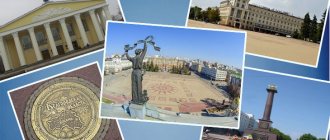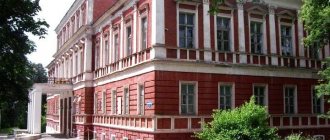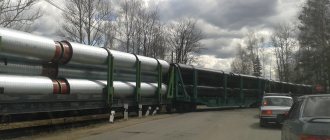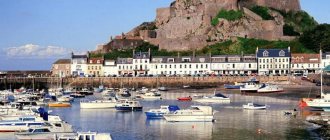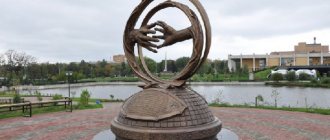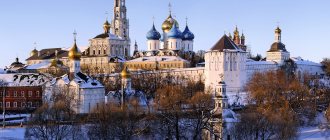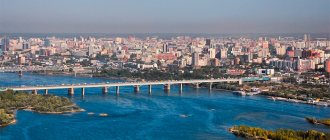You have asked many times and waited a long time for articles about Kaluga to appear on the blog. Catch it! This is the first article about this city, two or three more publications are planned, and I really hope (I will try) that I will have time to post them before leaving for Thailand.
Kaluga... To be honest, winter Kaluga does not inspire us at all to take long walks and write posts. Winter leaves its mark on this city, making it gray and cold. At least, after a walk through the Central district of this city (Kirova Street), this is exactly the impression one gets. But with the words “the profession of a blogger is obligatory,” Slava wrapped himself in a warm scarf, I put a hood on my hat, and we went for a walk and captured this city for you.
Kaluga is famous for the fact that Konstantin Tsiolkovsky, a famous inventor and astronautics theorist, lived and worked here. It is from his monument that we will begin our walk today. So, the sights of Kaluga.
Sights of Kaluga: Peace Square and Tsiolkovsky Monument
The monument to Tsiolkovsky is located in the greenery of Peace Square, which was formerly called Sennaya Square.
Of course, the greenery is not visible now, but I am sure that in the summer it is exactly like that.
The monument was opened on June 1, 1985 in honor of the 100th anniversary of the birth of the great scientist.
The monument is a granite pedestal with a bronze sculpture of a scientist and a silver rocket, which rises 18 meters high behind him.
At the entrance to the park from the “21st century” side, in honor of the celebration of the New Year 2016, an incomprehensible structure was installed, as if woven from wire, in the shape of a Christmas tree. In the evening the “Christmas tree” glows.
Especially for those who walk around the winter city, explore the sights of Kaluga and freeze like us, coffee machines are installed throughout the city center. There is exactly the same one on Teatralnaya Square. The coffee is sold at quite affordable prices, the taste is ok, but not wow.
We continue our walk from Peace Square towards Victory Square.
So the streets of Kaluga look gray... The snow that fell a few days ago is already more like asphalt in color. Roads and footpaths are sprinkled with some kind of reagent, so the snow in some places has turned into a vile slurry, which is very unpleasant to walk on. And more energy is spent on such walks, so you get tired faster.
But we move on. On our way...
This is interesting! Grieving mother in Bukhara returned home
What to see in Kaluga in 2-3 days
Before that, we told and showed the places that we saw ourselves. But at the very beginning of the post it was said that we absolutely did not have enough time. What follows is what we didn’t have time to see.
Museum of Crafts, Architecture and Life . The most ordinary “small-town” museum with a large collection of all kinds of collections. The House of Masters was enough for us, so we weren’t too upset that we didn’t get to the museum of everyday life. Although, they say, the collection of clay toys is excellent, there are even exhibits from the 17th century.
- Address of the Museum of Architecture and Life: Kirova St., 45/16
- Opening hours: from 10:00 to 18:00 (with excursion only); Weekends are Monday and Sunday.
Bilibin's house. The second name is Shamil's House. Now the mansion houses a branch of the local history museum. We did not plan this museum so as not to tire six-year-old Tanya with endless exhibitions (she had had enough of the cosmonautics museum, the planetarium and the House of Masters in Kaluga in 24 hours). But the museum is praised. And it is located in a historical building from the 19th century.
- Address: Pushkin St., 4
- Opening hours: 9:30 – 17:30, closed Monday
Kaluga Regional Art Museum (exists since 1918!). A decent collection of paintings and sculptures. Of course, it cannot be compared with the Tretyakov Gallery and the Louvre, but these paintings hang in an ancient building. Many tourists highly recommend this museum. Let's return to Kaluga - let's go and study what kind of collection of ancient Russian art is offered to a wide range of visitors.
- Address: Lenin st., 104
- Opening hours: 10:00 – 18:00, closed on Monday
Korobov's chambers. We didn't go inside, but walked around. The building itself is very interesting - real chambers from the 17th century (one of the oldest buildings in Kaluga). Inside, according to the sign, there is a department of the local history museum.
- Address: Plekhanov str., 88
- Opening hours are unclear, there was no sign
Chizhevsky Museum. It is worth going only with a guided tour, so that your acquaintance with the museum does not turn into just another viewing of various objects. Judging by the reviews, the excursion is interesting, especially if it is conducted by the head of the museum, Lyudmila Teobaldovna Engelhardt. We will also definitely look into this museum as soon as we find ourselves in Kaluga again, because there is something to see here.
- Address: Moskovskaya st., 62
- Opening hours: from 11:00 to 18:00 (on some days until 19:00 and until 20:00), closed on Monday
Zolotarev's estate. It houses a local history museum. We appreciated the estate from the outside (the courtyard with a colonnade is impressive). The excursions are interesting and almost interactive, recommended by all tourists. And the building itself is undoubtedly an architectural landmark of Kaluga.
- Address: Pushkin St., 14
- Opening hours: from 10:00 to 17:00, closed on Monday
If you still have time left and the weather permits, you can take a walk in the Kaluga Central Park of Culture and Culture.
Clean, neat, in the very center, good observation deck, etc. and so on. We really like such places, but, alas, there was absolutely not enough time..... And the last, most interesting, judging by the words of our friends, attraction of Kaluga is the Tsiolkovsky house-museum. In terms of significance and importance, the house-museum is equal to the museum of astronautics. We were severely scolded for not entering the museum. We scolded ourselves too.
- Address: Tsiolkovskogo st., 79/81
- Opening hours: 10:00 – 18:00, closed on Monday
If you have time (and desire!), we recommend going to Ethnomir - we really liked it. You can read about our impressions here: Ethnomir - prices, photos, how to get there and our reviews
Shopping and entertainment center XXI century
The 21st Century shopping center (Kirova St., 1), opened in 2005, is considered one of the landmarks of the central street. It has a cinema, shops, food courts, McDonald's, so if you are tired or cold, you can eat or warm up inside. The Kaluga Hotel is adjacent to the shopping center on the reverse side. As the guidebooks say, it is a business class hotel.
Opposite the "21st century" across the road...
White stone romantic
The express list of beautiful and interesting places in Kaluga ends with the stone bridge - the oldest stone viaduct in Russia. The construction of this white stone beauty was completed in 1785, its approximate length and height are 160 and 20 meters, respectively, and the entire structure contains about one and a half million tons of brick. This is not only the oldest, but also one of the strongest stone bridges in our country: originally designed for horse teams, it honorably withstood modern automobile traffic and even military equipment during the Great Patriotic War, although, of course, even this giant could not managed to avoid partial destruction and subsequent reconstruction.
The Kaluga viaduct lies across the picturesque Berezuevsky ravine, especially beautiful in golden autumn. You can take a leisurely stroll along the bridge at sunset, imagining how many years ago the city’s nobility took their evening exercise here. Couples in love also love to walk here, and in accordance with one of the city traditions, any newly-made husband must certainly carry his adored bride across the bridge in his arms. In general, we can assume that if a stone viaduct had a heart, it would definitely not be stone.
House of Music
The House of Music is located next to the courthouse at the address: st. Kirova, 6. The House of Music hosts famous musicians and musical groups on its stage. They say the acoustics here are very good. The hall of the music house can accommodate up to 250 people.
On the ground floor of the House of Music there is a photo exhibition and art gallery.
We won’t go inside; we’ll go further along Kirov Street towards Teatralnaya Square.
McDonald's looms ahead - an oasis for burger lovers
In the city center there are a lot of different shops and cafes where you can relax after a walk, have a snack or buy souvenirs.
The original administrative building "Gallery" with beautiful columns (Kirova St., 20).
Let’s move on and see another landmark of the city…
Temple in honor of the Holy Myrrh-Bearing Women
Not far from Theater Square there is a temple in honor of the Holy Myrrh-Bearing Women.
The current stone temple that we can see now was built in 1798. Before that, there was a wooden church in its place. According to believers, the best decoration of this temple is the iconostasis. During restoration work after the period of Soviet rule, it was given special attention to restore it to its former splendor.
Well, we are already approaching Theater Square. And it’s called that because (you guessed it) the theater is located here.
New Year - the whole year
“New Year's Capital” is a project created on the initiative of the Russian Ministry of Culture, aimed at increasing the flow of tourists and developing tourism within our country. The first such capital was chosen in 2012, it became Kazan, and then Vologda, Tambov, Tula and other cities. Having won the competition, Kaluga took the baton from last year’s New Year’s capital, Ryazan, and next year, 2022, the honorary status will be transferred to Nizhny Novgorod.
What does the status of the official New Year's capital give to the city? The fact is that in the modern world event tourism is actively developing, that is, just visiting and spending time in one place or another is no longer interesting to many. Whether it is thematic events or specific events, in many ways they can play a decisive role in increasing the tourist attractiveness of not only a particular city, but also the region to which it belongs. That is why Russian cities are seriously striving to get the coveted “snowflake” - the symbol of the project. After all, the status of the New Year's capital serves as an additional reason to invite more travelers and show them everything good and interesting, as well as attract investors to work on tourism infrastructure. In Kaluga, as well as in previous “capitals”, interesting events will be associated not only with the celebration of the New Year: the city is ready to make a pleasant impression on tourists in all its diversity.
pixels.com/Capture Blinks
Kaluga Regional Drama Theater
The theater's birthday is January 19, 1977. Initially, the theater was located on Sennaya Square, on what is now called Peace Square. The theater burned down several times and was rebuilt until it became what we can see now. I will not go into details of the theater’s biography, if you have interest and desire, read it on the theater’s website - teatrkaluga.ru.
This is interesting! Where to stay in Kaluga - a selection of good hotels
Near the entrance to the theater there is a sculpture of a girl with a piece of paper on which is written: “Do you have an extra ticket?”
I'll stand too
Well, during the Christmas holidays, a Christmas tree is installed in front of the theater, because Theater Square is the main place for all holiday festivities.
I got to meet Father Frost and Snow Maiden
You can see a theater poster right on the street, or you can do it without leaving your home - on the theater website
Opposite Theater Square, across the road, is located…
How to get to Kaluga
If you want to get to Kaluga by car, then at the very bottom of this page there is a form with route planning, a map and the ability to calculate approximate fuel consumption. For example, from St. Petersburg to Kaluga you can drive in 12.5 hours (861 kilometers); from Moscow - 3.5 hours (183 kilometers).
If you are traveling without a car, then trains run from Moscow to Kaluga from Kievsky Station, and from St. Petersburg you can travel by train from Moskovsky Station in 12 hours.
Theater Boulevard
Or as the residents of Kaluga call it - Kaluga Arbat. If you need souvenirs, then go here for them.
Sights of Kaluga
And Arbat begins with a present from Forabank - a bag of money
They say whoever touches it will definitely be happy. We don’t believe in omens, but we touched it anyway.
Kirova Street is the very center of Kaluga, parking here is paid, so parking meters are installed along the entire street.
The whole Cosmos is visiting us
But let's return to Kirov Street. Going down it to Peace Square, you can admire the bronze monument to Konstantin Tsiolkovsky, complemented by a steel rocket. And from there - straight to the State Museum of the History of Cosmonautics named after K. E. Tsiolkovsky, the true pearl of a tourist trip to Kaluga. This is the world's first museum dedicated to space. The outstanding designer of rocket and space systems, Sergei Korolev, and Yuri Gagarin, the face of the space industry and the main person of the last century, who was the first in the world to go into orbit (largely thanks to Tsiolkovsky), took a personal part in its creation. And in general, Konstantin Eduardovich is “everything from Kaluga.” And even despite the fact that he was born in the Ryazan region, many Kaluga residents sincerely believe that the great scientist was a native of Kaluga: Tsiolkovsky became so dear to local residents.
Global Look Press / Anton Kavashkin
The Museum of the History of Cosmonautics was opened in 1976 and to this day is considered the place that most fully reflects the history of aeronautics and the conquest of outer space. This is a fascinating exhibition, which it is recommended to spend at least an hour and a half to get acquainted with, regularly updated exhibitions and, of course, fascinating meetings and conversations with cosmonaut pilots. It is here that the backup of the famous Vostok rocket, on which Senior Lieutenant Gagarin roamed the expanses of space, is located.
Global Look Press / Ministry of Culture Russia
While exploring the main Kaluga attractions, descriptions and photos of which can become an adornment of any guide to these places, you cannot pass by the planetarium, located here - on the south side of the Tsiolkovsky Museum. Tourists from all over Russia come here to admire the stars, because in the “city of space” they are definitely closer and easier to understand. The planetarium in Kaluga, opened in 1967, was the first in the USSR. Here you can see satellites and constellations, planets and meteors, solar and lunar eclipses. And this is, perhaps, the best thing that you can see in Kaluga on your own in 1-2 days with children: a fascinating space journey, seasoned with special effects, will inevitably delight children of all ages. And it doesn’t matter what the weather is like outside: the sky in the Kaluga Planetarium is always clear and starry.
Not far from the museum and planetarium is the Tsiolkovsky house, in which Konstantin Eduardovich lived with his family for almost 30 years. Here the scientist wrote dozens of his works devoted to astronautics, aviation, jet propulsion and other scientific issues. In 1936, a year after the scientist’s death, a museum was opened in the building, the first exhibition of which told about the most significant areas of Tsiolkovsky’s activity. The work of the museum was forced to be interrupted during the Great Patriotic War. The Germans settled in the house, so many valuable exhibits were irretrievably lost. When the war ended, the liberated museum was restored and reopened to the public, and after the creation of the Museum of the History of Cosmonautics, it became its memorial department.
Church of John the Baptist
The church is located among administrative buildings, shops and residential buildings right in the city center.
The church houses the Tikhvin Icon of the Mother of God, which is considered miraculous, and a particle of the relics of John the Baptist, brought here from Montenegro.
We walk past the temple, past the Central Cinema...
To Rakov's house (75 Lenin St., intersection with Kirov).
Rakov's House
Rakov's house is affectionately called "shells" by Kaluga residents. Until 1917, this mansion belonged to the merchant Rakov, from which it received its current name. In Soviet times, there was “Children’s World” here, now there are shopping arcades, shops and cafes.
I also noticed a huge number of wires in the city center. This, of course, is not Thailand, but it is also “impressive”. In summer they are not as noticeable as in winter.
“Three pillars” of modern Kaluga
Kaluga was officially founded in 1371, but the history of this city goes back to ancient times. Modern Kaluga has absorbed three medieval settlements at once. The first of them was located at the mouth of the Kaluzhka River, at its confluence with the majestic Oka. The second was located higher up, in the area of the village of Zhdamirova, and the third settlement, built on the banks of the Yachenka River, is known as Simeonovo. Legends say that the city was moved to each of these “three pillars” three times, eventually absorbing the territory completely.
The city has long been famous for its developed folk crafts and the breathtaking art of icon painting. As for feats of arms, historically Kaluga was the southern outpost of Moscow, and for many centuries it regularly repelled the raids of conquerors.
There is no single version of the origin of the city's name. At first it was called Koluga, explaining that a certain Khan Uga captured these territories and, as a sign of conquest, drove a stake into the ground, so the city that grew up here began to be called the “Uga stake”. The name of the city is associated with the ancient Russian words “kalyga” (fence) and “kaluga” (swamp), and with the name of the ancient robber Koluga, but the most logical and plausible version of its origin is from the name of the local river Kaluzhka.
USEFUL TO KNOW : Kaluga is not only a city, but also a fish - an unusually large representative of the sturgeon family. True, kaluga does not live in Kaluga, but in the Amur basin, and it is impossible to taste it, since the fish is listed not only in the Russian, but also in the international Red Book.
Just as a theater begins with a hanger, a city begins with a train station. The main railway station in Kaluga is called Kaluga-1. The beautiful brick building was built at the end of the 19th century and is furnished quite laconicly: a modest station area, a standard waiting room, several ticket offices and miniature catering outlets with hot tea and pastries. To be fair, a few words should be said about Kaluga-2, which is not a station at all, but a standard station and a small village for railway workers. This place is better known as the departure point for Kaluga residents on vacation, since long-distance trains pass through the station.
Global Look Press / Anton Kavashkin
Victory Alley, sculptures of a policeman and a veteran
From the intersection of Kirov and Lenin streets, towards Victory Square, a pedestrian alley with benches begins in the middle of the roadway. A policeman with his faithful dog keeps order in the alley.
In winter, the alley is decorated with these “Christmas tree arches” with golden bells tied with a red and gold bow. At night, this section of the alley is illuminated with multi-colored lights from New Year's garlands.
At the end of the alley, on one of the benches, a veteran sat down to rest with his friend - a dog guarding his peace.
This is interesting! Gloomy Kaluga - a farewell walk through the provincial capital
Well, we have already approached Victory Square.
